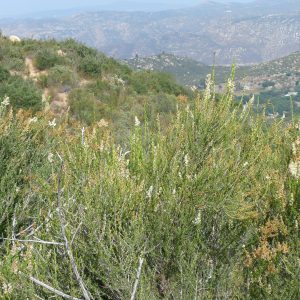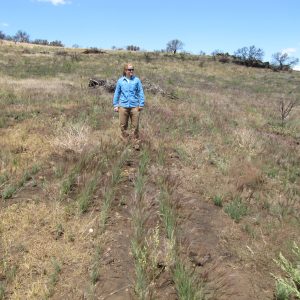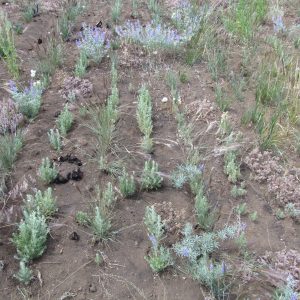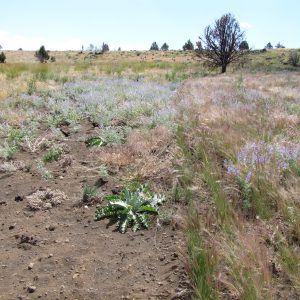 Although I have been helping people in my office to reintroduce native plants (sage brush, buffalo berry and winterfat), check exclusions fences around campsites on the Missouri River, do call surveys for raptors and other odds and ends, my main task lately has been conducting point counts for birds.
Although I have been helping people in my office to reintroduce native plants (sage brush, buffalo berry and winterfat), check exclusions fences around campsites on the Missouri River, do call surveys for raptors and other odds and ends, my main task lately has been conducting point counts for birds.
Point counts are a tool often used by wildlife biologists to estimate bird populations, and they work like this- make a transect line (often a road or trail) and stop periodically to listen and look for birds, then record what species you found and how many of each. This by no means gives you hard figures, but rather something to compare to other areas and years. Back in 1998 our field office employed an avid birder who took it upon himself to get in-depth estimates of bird populations within our district. Now that it has been more than ten years I was eager to re-do his point counts, see how things have changed and estimate causes.
In addition to the satisfaction of getting the most up-to-date data, I enjoy conducting point counts because I see something new or unexpected every day. I am constantly having to look up new birds and calls and am expanding my knowledge base. So far I have been able to see neat things like Hawks fighting, curlews getting really up close to yell at me and rare birds like Sprague’s Pipits and Loggerhead Shrikes.
 Loggerhead Shrikes, also known as ‘butcherbirds’, are a very interesting species who maintain the delicate body type and feet of a songbird but have evolved a hooked beak with which they can sever the spines of lizards, snakes and even other birds. As a result you have a sweet-looking bird with the not-so-nice habit of skewering prey on barbed wire to hold it in place while it tears off pieces- hence the gruesome nickname. Sprague’s Pipits are known for having the longest flight display of any bird (one was recorded going for three hours non-stop; a trick that would consume half of his fat reserves!)
Loggerhead Shrikes, also known as ‘butcherbirds’, are a very interesting species who maintain the delicate body type and feet of a songbird but have evolved a hooked beak with which they can sever the spines of lizards, snakes and even other birds. As a result you have a sweet-looking bird with the not-so-nice habit of skewering prey on barbed wire to hold it in place while it tears off pieces- hence the gruesome nickname. Sprague’s Pipits are known for having the longest flight display of any bird (one was recorded going for three hours non-stop; a trick that would consume half of his fat reserves!)
I am now done with my rounds and on to analyzing data, and one trend I noticed was a decrease in sagebrush-dependent birds towards mid-story grassland favoring ones. This is a fairly common result of human activities, and is not surprising when that is what the BLM and ranchers manage for grazing.
Monthly Archives: August 2011
Blog Entry : Miguel Kaminsky, Escondido CA
This week has reminded me of the inherent divergence between human and plant scheduling. Twice this week, I ventured to the field thinking I was going to collect a particular species and returned with a different collection than anticipated. First, I went to the field expecting to get Malosma but instead got Hesperoyucca. Secondly, I went in search of Ceanothus and returned with Arctostaphylos (Manzanita).
The Arctostaphylos seed harvest was one of the funnest things I did in the last couple of weeks. It took place on a 50% slope overlooking a valley. I also gave the seeds a taste test, and they were surprisingly delectable. They tasted like rose hips. I am thinking about making Arctostahylos mead in the future. I am having a blast collecting lots of seed in this bioregion that is new to me.
The end is only a new beginning
Coming out of July, I spent three days backpacking the Lost Coast in the King Range with two other BLM employees, Paul, a wilderness ranger and Aaron, a fish biologist. Access to the King Range is generally restricted to hiking; not just because of the wilderness designation but also the shear wicked topography limits wheeled vehicles. This black sands coastline has massive cliffs dropping straight down with intermittent rolling prairies, nothing like I had seen in Oregon.
Along the trail Paul was greeting fellow backpackers and answering questions, mostly about bears and suitable camp areas, while Aaron, placed temperature probes in streams. My purpose here was to map selected noxious weeds with the Juno unit and then pulling the exotics.
The last field night out some black bears raided camp, going straight for the bear cans and avoiding our tents that we were sleeping in altogether. The bears shook and rattled the cans, eventually waking everyone up as we shouted, “Hey Bear! Hey Bear!” until they wandered off into the night. Following the tracks next morning we assumed the bears probably checked out other adjacent backpacking camps for a meal.
Fast forward a week or two and Ive spent my time collecting seed for natives such as Curly Wallflower (Erysimum menzseii ssp. concinnum), which seemed to grow exclusively within patches of poison oak which definitely was not the most enjoyable seed collection. Yellowtinge Larkspur (Delphinium decorum) and Large-leaf Sandwort (Moehringia macropyhylla) both had their challenges but perseverance prevailed and we eventually had enough for SOS.
Now its August and I’m saying goodbye to the Arcata Field Office. I have never worked with a group of such supportive and passionate individuals who not only care deeply about our natural resources but about maintaining positive public relations. I have learned a tremendous amount of field methodology and techniques, as well as acquiring a stronger understanding of the botanical realm. I feel lucky to have experienced Northern California in ways most people have never seen. Because I started in March I can still get some summer road trips in before the real world takes over my life again. Thanks to the Arcata Field Office, my terrific boss Jennifer and of course, thank you Krissa and Marian!
Exploring
I grew up in the Southeast, lived in the same place for 23 years, and went to a college in the same state. I vacationed in a few places on the East Coast and I had never been passed the Mississippi River. I envied all of my friends that went all across the United States and out of the country. I was determined to explore the rest of the States and to leave my comfort zone.
Part of the reason why I applied for this internship was so I could make a major change in my life……
BOOM
I got planted on the other-side of the country leaving my friends and family. I drove the across the entire country just so I could experience more of what is out there. I really needed this major change in my life so that I could figure out what is important in my life. The big idea here, is what is best for me. Some may say it was selfish for me to leave my family, others may agree with me, but what mattered was, what I needed to do to make my life better.
Basically, I needed to travel and see what other states/cities had to offer. California is a huge state and has so many different climates/habitats/ecosystems, it is crazy to see them all. Waking up to a view of the mountains in a city and then driving an hour to see a desert, and then walking a few miles to find a palm oasis is kind of disorienting, especially coming from a state where it basically is a temperate forest.
If I grew up in the West and moved to the East I may feel the same way about the East Coast having several different habitats etc., but it is refreshing to experience something new. So I made it one of my goals to try and experience as many new surroundings as possible.
I just took a mini vacation to San Francisco which is about 8-9 hours from where I am stationed in Palm Springs. I am working in the desert, where the temperatures reach about 120 degrees in the shade! I get to San Francisco and I have to wear jeans and a jacket in order to keep warm! It is baffling to realize that I drove that far and I am only halfway through the state.
San Francisco was a blast! I went to the Golden Gate Bridge, the Golden Gate Park, Fisherman’s Wharf, and meandered through all of the neighborhoods that were located within the city. I tried booking a tour of Alcatraz, but unfortunately they were full, looks like I just have to come back to do this! It is definitely a fun city, and I could picture myself living there!
My other goals are to head to Death Valley, and then Sequoia National Forest, I can not wait to explore these areas! Thanks Chicago Botanic Garden!
We have been done with our spring SOS seed collecting for a couple of months now and have been stuck in the office doing loads of computer and paper work. It took us 4 or 5 weeks to get through all of the important stuff and now we have some free time. Hooray! I’ve been taking advantage of the free GIS courses I signed up for through BLM. I mostly self-taught myself to use ArcGIS, so learning the actual best way to do things is very interesting. I’ve also gotten to help out on rare plant surveys and other projects that I don’t usually have time for. We have some awesome trips planned for the Fall, so now we wait. Even though I’m stuck in the office during the week, I still get plenty of time outdoors on the weekends.
Three Months In
I applied for this internship in the name of professional and personal growth. Writing blog entries aids in my reflection of my experiences and therefore facilitates self-awareness and growth. Thanks for reading.
My best friend, Quincy, and I in Ten-Sleep canyon
Day-to-Day
I am assigned to the Range division of the Resource department of the BLM (Bureau of Land Management). I perform ecological health assessments of BLM rangeland leased for livestock grazing. This entails identifying grasses, forbs, and shrubs and estimating percent cover of the foliage. The data collected are then interpreted and compared to previous assessments to help determine how many animals can graze on the land without jeopardizing ecological integrity.
Data Collection –Reading Trend Plots
Big Picture
Almost everyday I journey to unfamiliar, remote parts of Wyoming. I can logically interpret my location from practice creating and reading maps. Before I started this job I couldn’t even open the GIS ArcMap program. Now, I feel comfortable navigating the program and creating maps that myself and others can follow. The ability to use this program has fostered independence at my job. This independence encourages creativity and has also given me a sense of ownership of my assignments.

Hole-In-The-Wall Ranch horses–Just another day in the field
Self-awareness
Living and working with a person who is just as smart, talented, interesting, and stubborn as oneself requires compromise. I’ve learned that some important elements to compromise are communication and humility. I try to practice compromise daily. Sometimes I fail, sometimes I succeed. I am learning that compromise can lead to a more balanced and harmonious relationship.
Land of Enchantment
Since I last wrote about New Mexico I have had several opportunities to explore outside of the Las Cruces area. One weekend we trekked to Carlsbad to see the caverns and watch the bats fly, the next trip was camping, hiking and checking out the cliff dwellings in the Gila Wilderness which was absolutely breathtaking, and last weekend was spent in attendance at the Native Plant Society of New Mexico Workshop in Santa Fe.
The weekend in Santa Fe allowed us to hear lectures covering topics ranging from various plant pollinators and their importance, to the paleogenic history of New Mexico, and the challenges in organizing taxonomy and writing identification keys. Although we brought the average age of the group down significantly, we were welcomed by the Native Plant Society and learned a great deal from the speakers, field guides, and even the other attendees.
Unfortunately drought is still delaying our progress with seed collections. I have been in Las Cruces since the middle July and have only taken part in one of the two collections that our team has made. We found the seeds of the Helenium microcephalum in primo condition when we went scouting around the Potrillos Mountain Range. Despite the lack of viable seeds ready for collection, we have been keeping quite busy with our surveying of button-sized cacti called Escobaria duncanii, Duncan’s Pincushion. A population was discovered and hand-mapped by our mentor in 1989 along limestone ridges in Mudspring Mountains near a town called Truth or Consequences. It is our task to record the current GPS coordinates, health, associated species, and community size of each Pincushion we find in the mountain range. The size and similarity to other cacti on the range makes this more of a challenge (see pictures).
Luckily our rain dances are starting to pay off. The crispy burnt areas in Southern New Mexico are starting to become green and rain showers are becoming more prevalent. I have high hopes of seeds to come and until the do we’ll keep hoping for more rain.
A seeding success!
Seed collection continues to be at the forefront of my activities in Alturas, but I have been able to find time to go out and learn about other projects as well. During the past two weeks I have worked with a rare plant monitoring team from the US Forest Service, banded ducks and geese at the Modoc National Wildlife refuge, electroshocked fish with the California Dept. of Game and Fish, and worked with various people within my BLM office on their current projects. It has been very rewarding to continue pushing ahead with my project while getting to help out with others.
This past week I was able to go out with my mentor to an area that had burned last year and then been seeded after the fire. The fire had burned very hot, and only a few carcasses of junipers were left in much of the area. Driving toward the hillside where the seeding had taken place, we could see that it was dominated by patches of purple. As we drew closer, we could see that the patches were huge numbers of silvery lupine (Lupinus argenteus var. heteranthus) in bloom. There was also a lot of goosefoot (Chenopodium spp.), Phacelia spp., and Basin wildrye (Leymus cinereus). We got out to take a closer look and could see neat rows of squirreltail (Elymus elymoides), and tiny Mountain big sagebrush (Artemesia tridentata ssp. vaseyana). These were the species that had been planted to previous fall, and they seemed to be thriving after the long, wet spring. It was really exciting to see the sagebrush seedlings because no one was sure how well they would do from seed. Another interesting things we noticed was that the weeds did not seem to do as well in the seeded areas when compared to the non-seeded areas right next to them. Scotch thistle (Onopordum acanthium) and cheatgrass (Bromus tectorum) are major problems inthe area, especially following fire, but they did not seem to establish in the seeded areas. It was hard not to get too excited about these results because it had been such an unusually wet year and because two years after a planting is generally a better indicator of sagebrush seedling success, but it was still great to see that this seeding was showing positive results and that in this case, a post-fire treatment was making a difference in rangeland health.

- Rows of squirreltail and sagebrush seedlings
- Rows of seedlings planted last fall
- On right: squirreltail and sagebrush seedlings. On left: scotch thistle and cheatgrass dominate
Always an Adventure
Only three months left of my internship and I cannot believe how quickly time is moving. Right now there is a lull in seeding plants, so I have been able to help out other groups in the office with their projects.
Over the past few weeks I have been involved in several riparian assessments. It is important to monitor riparian areas to make sure they are functioning properly, due to their high ecological value. These areas help filter the water of sediments and other pollutants, reduce soil erosion, dissipate energy from the stream, and support unique plant and animal communities.
Currently I am packing for the Annual Native Plant Society of New Mexico Meeting in Santa Fe. There I will learn about the society and meet other people who are passionate about native plant species. Along with lectures and workshops, there are many field trips organized to go out and explore the surrounding natural areas.
Below I have included my favorite picture of the month. This was taken at the De-Na-Zin Wilderness area. I have been enjoying my time in Farmington, NM and look forward to the coming months.
Back in the Great Basin
This is my second CLM internship, and also my second time living in Carson City, NV. This year I am participating in a different project with the BLM – monitoring and surveying the nearly threatened sage grouse habitat. This has meant much more hiking than last year, often far from a road of any kind, over rough terrain and in sweltering heat. All this off-trail trekking means that I’ve been able to see much more of the landscape than ever before, not to mention more of the wildlife. In one day last week we saw a heard of antelope, 3 goshawks and a red tail, several types of lizards, a rattlesnake, and lastly a scorpion (which incidentally decided to take up residence under my sleeping bag)! We have yet to see any bighorn sheep, but I’m hopeful that I’ll get to see some again this year before the internship is up.
I’ve heard a few people scoff at the fact that Nevada is the most mountainous state in the lower 48 (“Nevada has 172 mountain summits with 2,000 feet (610 m) of prominence. Nevada ranks second in the US, behind Alaska, and ahead of California, Montana, and Washington. This makes Nevada the “Most Mountainous” state in the country, at least by this measure.” http://en.wikipedia.org/wiki/Nevada). I invite these people to try hiking a few miles off trail and see what they think of Nevada’s mountains, and no, that does not mean taking your ATV! That means using your legs and lungs and sweat glands = HIKING. Many people in Nevada have an aversion to walking for some reason. And whenever I go hiking in the Sierras,despite being on the state line, the majority of what I encounter are people from California and their dogs. I think this lack of “walking about” may contribute to Nevada’s lack of public interest in Public Lands. The land seems to be used more for free dumping than anything else. Perhaps if Nevadans could trouble themselves to leave their cars for long enough to appreciate what they have all around them, they would come to the same conclusion that I have. Namely, that their state is incredibly diverse and beautiful, and that it deserves better treatment and care.
Many things can be deemed nice and even beautiful from behind a pane of glass, rolling down the highway. But, some things have to be experienced in a physical way. You have to have the sun on your neck, grit in your teeth and the dust of a place in your nose before you can truly appreciate that summer storm and the way the rain makes the smell of sage hang in the air.


















